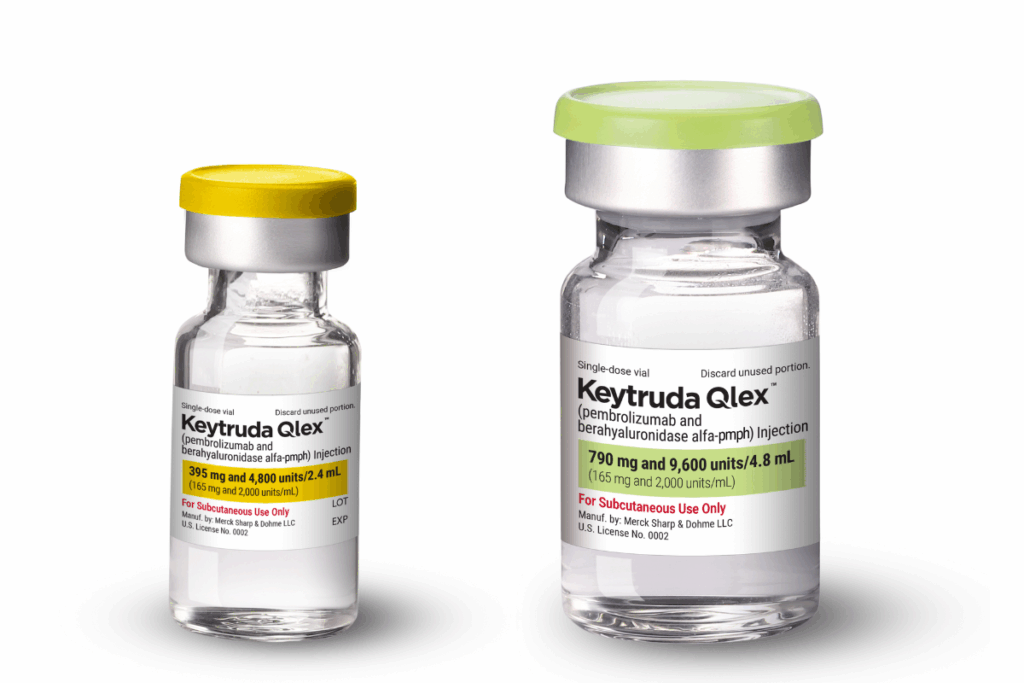Merck’s Keytruda Qlex (pembrolizumab and berahyaluronidase alfa-pmph) is FDA-approved for subcutaneous use in adults across 38 solid tumor indications already cleared for intravenous (IV) Keytruda (pembrolizumab). This includes melanoma, lung, bladder and head and neck cancers.
The therapy is the first immune checkpoint inhibitor (a type of immunotherapy that helps the immune system detect and destroy cancer cells) that healthcare providers can administer subcutaneously in as little as one minute.
Merck expects Keytruda Qlex to be available in the US in late September. The new formulation delivers comparable effectiveness and safety to IV Keytruda, offering a faster and less invasive option for patients and clinicians.
Keytruda is among the most commonly used immune checkpoint inhibitors.
What Keytruda Qlex Is and How It Works
Keytruda Qlex combines pembrolizumab, a PD-1 blocking antibody, with berahyaluronidase alfa, an enzyme that improves absorption when injected under the skin. This combination allows the same active therapy used in IV Keytruda to be delivered subcutaneously.
The injection follows the same dosing intervals as IV Keytruda, administered every three or six weeks, and is delivered in just over a minute for the lower-volume dose (2.4 mL) or about two minutes for the higher-volume dose (4.8 mL).
XTALKS WEBINAR: Smarter Site Feasibility Strategies for Predictable Enrollment in Late-Stage Oncology Trials
Live and On-Demand: Wednesday, October 29, 2025, at 11am EDT (4pm CET/EU-Central)
Register for this free webinar to gain a forward-looking perspective on how oncology trials can evolve to improve efficiency and patient outcomes in a highly competitive landscape.
Clinical Trial Data Supporting Approval
The FDA’s decision was based on the Phase III MK-3475A-D77 trial, a randomized, multicenter, open-label study comparing subcutaneous Keytruda Qlex with IV pembrolizumab in 377 patients with treatment-naïve metastatic non-small cell lung cancer (NSCLC) without EGFR, ALK or ROS1 genomic changes.
Patients were randomized 2:1 to receive Keytruda Qlex (790 mg/9,600 units) every six weeks plus chemotherapy or IV pembrolizumab (400 mg) every six weeks plus chemotherapy.
The study met its primary pharmacokinetic (PK) endpoints, showing comparable pembrolizumab exposure between the subcutaneous and IV formulations.
Keytruda Qlex achieved an overall response rate (ORR) of 45% compared to 42% for IV Keytruda, with no significant differences in progression-free survival (PFS) or overall survival (OS) between the groups.
These findings confirmed that the subcutaneous formulation provides similar clinical outcomes and exposure as the IV version, meeting the FDA’s standards for therapeutic equivalence.
Ongoing studies are expected to explore additional pembrolizumab combinations and new administration methods across several tumor types.
The safety profile of Keytruda Qlex was consistent with IV Keytruda. The most common side effects, occurring in at least 20% of patients receiving Keytruda Qlex with chemotherapy, were nausea (25%), fatigue (25%) and musculoskeletal pain (21%).
Convenience and Access of Keytruda Qlex
With its under two-minute administration, compared to roughly 30 minutes for IV infusions, Keytruda Qlex could potentially reduce treatment time for patients and oncology centers. It can also be given in different care settings, offering flexibility to oncology teams and improving access for patients who live far from infusion centers.
For patients who do not need a port or have difficult-to-access veins, this route may simplify cancer care.
Looking Ahead: The Checkpoint Therapy Landscape
Checkpoint therapy continues to evolve through new business moves, clinical milestones and next-gen research.
Corporate Expansion and M&A
In mid-2024, Boehringer Ingelheim acquired Nerio Therapeutics for up to $1.3 billion, adding preclinical small-molecule inhibitors targeting PTPN1 and PTPN2, enzymes that regulate T-cell activity as immune checkpoints.
Earlier this year, Sun Pharma acquired Checkpoint Therapeutics, bringing Unloxcyt (cosibelimab-ipdl), an FDA-approved anti-PD-L1 therapy for advanced cutaneous squamous cell carcinoma, into its oncology portfolio.
Clinical Development Activity
SillaJen, a South Korea-based biotech, got FDA approval for a Phase I US trial evaluating BAL0891 with tislelizumab (anti-PD-1) for triple-negative breast and gastric cancers.
In Exelixis’ Phase III STELLAR-303 trial, zanzalintinib plus atezolizumab (anti-PD-L1) improved overall survival in metastatic colorectal cancer, while BeiGene (now BeOne Medicines) discontinued its anti-TIGIT antibody (ociperlimab) in lung cancer after a futility analysis.
New Directions in Immunotherapy
Merck’s Phase III KEYNOTE-B96 study showed a statistically significant survival benefit in platinum-resistant ovarian cancer. This is the first immune checkpoint regimen to do so in this setting.
Beyond antibody-based therapies, biotech innovation is exploring new immune-modulating platforms. Forlong Biotechnology is advancing FL115, an IL-15 superagonist built on its Fbody synthetic immunology platform, now in Phase I studies with PD-(L)1 antibodies for advanced solid tumors, a next-gen approach to enhance immune responses in cancers less responsive to checkpoint inhibitors.
If you want your company to be featured on Xtalks.com, please email [email protected].












Join or login to leave a comment
JOIN LOGIN